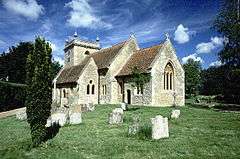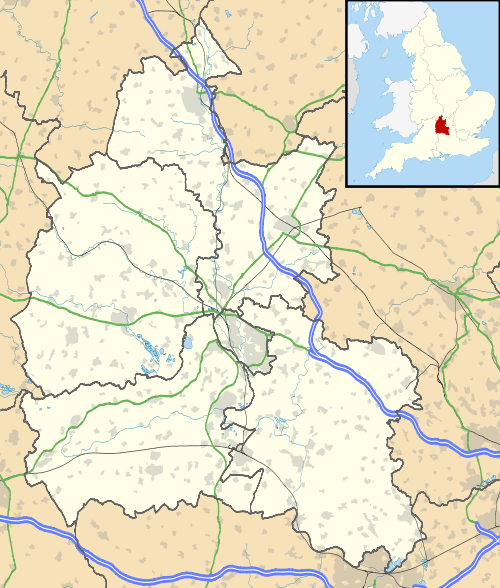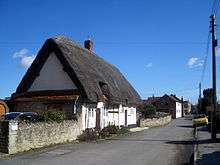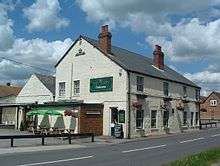Stadhampton
Stadhampton is a village and civil parish about 5 miles (8 km) north of Wallingford, in South Oxfordshire, England. Stadhampton village is on the A329 road and close to the River Thame.
| Stadhampton | |
|---|---|
 Parish church of St John the Baptist, seen from the southeast | |
 Stadhampton Location within Oxfordshire | |
| Area | 9.80 km2 (3.78 sq mi) |
| Population | 832 (parish, including Chiselhampton, Brookhampton and Ascott) (2011 Census) |
| • Density | 85/km2 (220/sq mi) |
| OS grid reference | SU6097 |
| Civil parish |
|
| District | |
| Shire county | |
| Region | |
| Country | England |
| Sovereign state | United Kingdom |
| Post town | Oxford |
| Postcode district | OX44 |
| Dialling code | 01865 |
| Police | Thames Valley |
| Fire | Oxfordshire |
| Ambulance | South Central |
| UK Parliament | |
| Website | Stadhampton Grapevine |
Location
The parish is about 10 miles (16 km) south-east of Oxford and includes the villages of Stadhampton and Chiselhampton and hamlets of Brookhampton and Ascott. The 2011 Census recorded the parish's population as 832.[1]
The River Thame separates Stadhampton and Chiselhampton. Stadhampton and Brookhampton are separated by a brook that flows through Chalgrove and joins the Thame just above Chiselhampton Bridge. Northwest of Chiselhampton is Richmond Hill, whose summit is more than 279 feet (85 m) above sea level.
Toponym
The toponym "Stadhampton" was recorded as Stodeham in 1146 and Stodham in 1316.[2] Stadham has also been used.[3] The name is derived from Old English, probably Stod-hāmm meaning "river meadow where horses were kept".[2] The "ton" suffix seems to have been added relatively late in the village's history.[3]
Parish church
The oldest part of the Church of England parish church of St John the Baptist is the 12th-century Norman baptismal font. Some 15th-century Perpendicular Gothic features survive, including the north aisle, three-bay north arcade and the chancel arch.[4][5]
The church has a west tower that was built in 1737. In 1875 the church was rebuilt and enlarged to designs by the Gothic Revival architect EG Bruton, who added a south aisle and three-bay south arcade.[4][5]
The tower has a ring of four bells. Henry I Knight of Reading, Berkshire cast the treble and second bells in 1621.[6] Mears and Stainbank of the Whitechapel Bell Foundry cast the third bell in 1883 and the tenor bell in 1884.[6] For technical reasons the bells are currently unringable.[6]
Since the Reformation St John's has always had the same parish clergy as St Mary's, Chiselhampton. The Welsh clergyman and writer John Roberts was priest of both parishes 1798–1803.
Economic and social history

In the 18th century Stadhampton had two clockmakers: James Jordan (born about 1751) and Thomas Jordan, who worked together.[8] Thomas repaired the turret clock at St Peter's parish church, Great Haseley on several occasions between 1770 and 1790.[8][9]
The village includes several buildings of historical and architectural interest, including a number that are Grade II listed. The former Black Horse public house on Thame Road was built in 1751.[10] Ash Cottage in School Lane is formed from three former cottages dating from the 17th century, now a single house. On the main street is a 17th-century bakehouse, thatched and built of coursed stone and bearing the date 1658, that was used as a bakery until about 1914.[3]
Amenities

Most of the amenities of the parish are in the village, including Stadhampton Primary School.[11] Stadhampton village school used to be at the bottom of School Lane but is now in Cratlands Close.
The parish has three pub-restaurants: The Coach & Horses Inn[12] in Chiselhampton and The Crown[13] and the Crazy Bear Hotel[14] in Stadhampton. Stadhampton has a petrol station that includes a village store.
Oxfordshire Animal Sanctuary is in Stadhampton.[15]
Thames Travel bus route T1 serves Stadhampton six days a week, linking the village with Oxford via Garsington and Cowley and with Watlington via Chalgrove. Buses run hourly from Mondays to Fridays and every 125 minutes on Saturdays. There is no Sunday service.[16]
References
- "Area: Stadhampton (Parish): Key Figures for 2011 Census: Key Statistics". Neighbourhood Statistics. Office for National Statistics. Retrieved 1 July 2016.
- Ekwall 1960, Stadhampton
- Lobel 1962, pp. 81–92.
- Sherwood & Pevsner 1974, p. 776.
- Historic England. "Church of St John the Baptist (Grade II) (1193931)". National Heritage List for England. Retrieved 15 July 2018.
- Walker, Mark (26 November 2006). "Stadhampton S John Bapt". Dove's Guide for Church Bell Ringers. Central Council of Church Bell Ringers. Retrieved 27 March 2012.
- Historic England. "Thatched Cottages (Grade II) (1193871)". National Heritage List for England. Retrieved 15 July 2018.
- Beeson 1989, p. 116.
- Beeson 1989, p. 40.
- Historic England. "Black Horse Cottage (Grade II) (1368737)". National Heritage List for England. Retrieved 15 July 2018.
- Stadhampton Primary School
- The Coach and Horses
- The Crown Archived 28 September 2007 at the Wayback Machine
- Crazy Bear Group: Stadhampton
- Oxfordshire Animal Sanctuary
- "T1". Timetables & Fares. Thames Travel. Retrieved 15 July 2018.
Sources
- Beeson, CFC (1989) [1962]. Simcock, AV (ed.). Clockmaking in Oxfordshire 1400–1850 (3rd ed.). Oxford: Museum of the History of Science. p. 116 0. ISBN 0-903364-06-9.CS1 maint: ref=harv (link)
- Ekwall, Eilert (1960) [1936]. Concise Oxford Dictionary of English Place-Names (4th ed.). Oxford: Oxford University Press. Stadhampton. ISBN 0198691033.CS1 maint: ref=harv (link)
- Lobel, Mary D, ed. (1962). "Stadhampton". A History of the County of Oxford. Victoria County History. 7: Thame and Dorchester Hundreds. London: Oxford University Press for the Institute of Historical Research. pp. 81–92.CS1 maint: ref=harv (link)
- Sherwood, Jennifer; Pevsner, Nikolaus (1974). Oxfordshire. The Buildings of England. Harmondsworth: Penguin Books. p. 776. ISBN 0-14-071045-0.CS1 maint: ref=harv (link)
